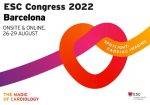Coronary artery disease in women usually develops 10 years later than in men, and some evidence suggests women have higher mortality, especially when it comes to ST elevation MI (STEMI). Registries have shown higher mortality both in hospital and at one year follow up. In part, this difference is observed because of the gap in...
ESC 2022 | REVIVED-BCIS2
The REVIVED-BCI2 included 700 patients with ejection fraction ≤35% with extended coronary artery disease and plausible PCI. Patients were randomized to PCI plus optimal and complete medical treatment (OMT) according to the current guidelines. 347 patients received PCI and 353 OMT. Primary end point was all cause death and hospitalization for cardiac failure. There were...
Adherence to P2Y12 Inhibitors in Acute Coronary Syndrome: Prognosis
Non-adherence to medication in patients with acute coronary syndrome (ACS) remains to be solved; the use of polypills and a closer follow up have been tried out (follow up calls and motivation groups). Antiaggregation guidelines recommend dual antiplatelet therapy (DAPT) for at least one year after ACS. Adherence to drug treatment is comprised of multiple...
TAVR in Bicuspid Patients: Are Outcomes the Same in Men and Women?
Bicuspid aortic valve stenosis (BAV) has not yet been analyzed in large, randomized studies, and TAVR in this scenario has been assessed only by small fairly studies. However, the information available is quite promising. TAVR in women generally presents more complications than in men, but severe bicuspid aortic valve stenosis receiving TAVR has not been...
Aspiration Thrombectomy in Acute Coronary Syndrome: Is the Japanese Perspective a Strategy to Emulate?
Aspiration thrombectomy (AT) in patients with high thrombotic burden could pathophysiologically reduce thrombus burden, decrease distal embolization, reduce no-reflow phenomenon, and improve microvascular perfusion. However, its usefulness has not been shown in the large, randomized trials (TASTE and TOTAL) that compared routine use of AT in primary angioplasty in patients with ST-segment elevation acute coronary...
Balloon expandable vs Self-Expanding Valves: The Best Option for ViV-TAVR in Small Annuli
TAVR has consolidated as an increasingly valid alternative to treat failed surgical aortic valve bioprostheses. One of the major challenges it presents is patients with small annuli treated with a surgical bioprosthesis. There is little data available about this scenario. A few observational studies have shown what appears to be a hemodynamic advantage of...
MitraClip in Patients with COPD: a Valid Option
Chronic obstructive pulmonary disease (COPD) and cardiovascular disease are associated to hospitalization and mortality. When associated to severe mitral regurgitation, not only do these two conditions have poor evolution, but they also limit the possibility of surgical valve replacement, given its high risk. Edge-to-edge repair with MitraClip has been shown beneficial in a group of...
Ticagrelor Monotherapy: Valid after 12 Months?
Recent studies on antiplatelet antiaggregation support the use of short dual antiaggregation therapy (DAPT), even in unforeseen scenarios, such as complex PCI. On the contrary, in patients with high ischemic risk, there is still evidence in favor of prolonged antiaggregation, mainly through the DAPT study, which showed lower risk of major ischemic events with DAPT...
The Best of the SOLACI-SOCIME 2022 Main Arena: Day 3
Lecture by Dr. Hector García García – LM-PCI: IVUS and FFR/IFR? Dr. Hector García delivered an excellent presentation on whether we should use intravascular ultrasound (IVUS) or fractional flow reserve (FFR)/instantaneous wave-free ratio (iFR) in the left main coronary artery (LMCA) to consider severe obstruction, since there is significant interobserver variability with angiography. Although the...
The Best of SOLACI-SOCIME 2022 Main Arena – Chronic Total Occlusions (CTO)
How to Choose the Best Approach in Chronic Total Occlusions, by Dr. Jean-Michel Paradis CTO are present in around 16 to 20% of patients with coronary artery disease who get a coronary angiography. CTO Percutaneous intervention has been on the rise, mainly due to equipment and technique advancement. During his presentation, Dr. Paradis mentioned the...








